The stairs to the left of the escalator don’t just look like a piano keyboard, but make musical sounds as people walk on each step.
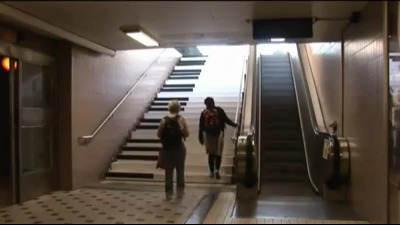 Not convinced this will work? Check out this video, which shows people heading towards the escalator, and then changing direction when they realize how fun it will be to climb the stairs.
Not convinced this will work? Check out this video, which shows people heading towards the escalator, and then changing direction when they realize how fun it will be to climb the stairs.
A Picture Putting Risks into Perspective
The National Health Service in the United Kingdom has recently disseminated a wonderful graphic, helping people understand how likely they are to die from scary things, like war and airplane accidents, versus less terrifying but deadlier hazards, such as high blood pressure and high cholesterol:
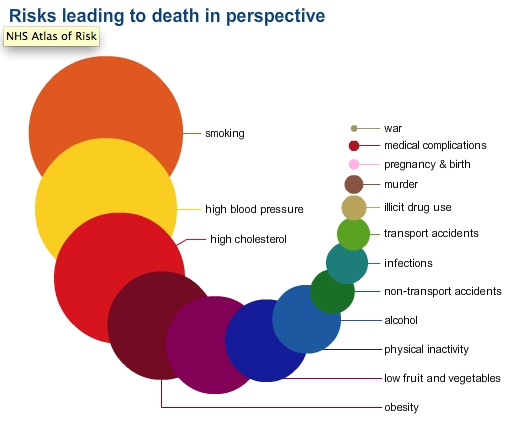 In behavioral economics, we talk about something called the “availability heuristic,” a fancy term meaning – when we try to guess how likely things are to happen, we use as a simple rule of thumb how easily instances of those occurrences come to mind. Things that come easily to mind, we assume, are more common. It’s easy to think of airplane accidents, because they’re covered in the news. Nothing newsworthy about a 90-year-old man dying from smoking related illness. This graphic is powerful, because it acts as a visual reminder of what we really ought to be scared about.
In behavioral economics, we talk about something called the “availability heuristic,” a fancy term meaning – when we try to guess how likely things are to happen, we use as a simple rule of thumb how easily instances of those occurrences come to mind. Things that come easily to mind, we assume, are more common. It’s easy to think of airplane accidents, because they’re covered in the news. Nothing newsworthy about a 90-year-old man dying from smoking related illness. This graphic is powerful, because it acts as a visual reminder of what we really ought to be scared about.
How Healthy Food Could Make You Fat
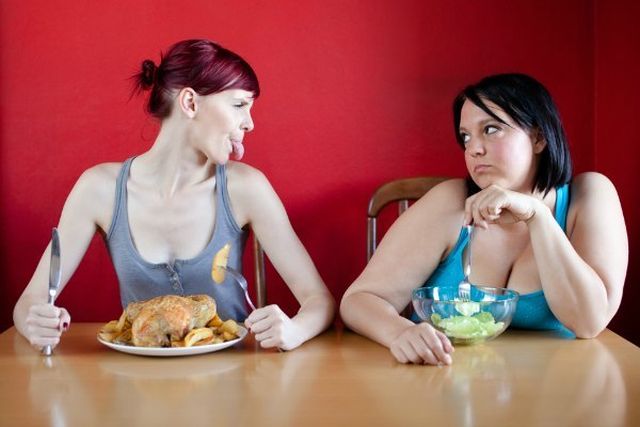 Have you ever eaten a healthy meal, maybe some brown rice and stir-fried veggies, and found yourself ready for another meal just a short while later? Or, more often couldn’t overcome a hankering for a satisfying dessert to top off (and undermine the healthiness of) that meal?
Have you ever eaten a healthy meal, maybe some brown rice and stir-fried veggies, and found yourself ready for another meal just a short while later? Or, more often couldn’t overcome a hankering for a satisfying dessert to top off (and undermine the healthiness of) that meal?
As it turns out, this lack of satiety is not merely a function of the lack of calories in your entrée, but also reflects an unconscious connection between your perceptions of how healthy the meal is, and your hormonal response to said meal. That’s the bottom line of research conducted by Alia Crum, a researcher at Stanford University.
Crum presented people with vanilla milkshakes and convinced some people the shake was a no-fat, low-sugar health drink and others that it had enough sugar and fat to feed a large family. (Okay; slightly exaggerating.) She discovered that people eating the “healthy” milkshake (which, of course, was identical to the unhealthy one) experienced an elevation of a hormone called ghrelin, which slows metabolism and stimulates appetite. Those believing that the shake was unhealthy, on the other hand, experienced a drop in ghrelin, and thus were more satisfied.
Think about what this means for dieters. They eat healthy meals in hopes of losing weight and their damn bodies fight back, hoarding on to the calories they’ve consumed while, simultaneously, telling them they need to consume even more calories. (To read the rest of this article and leave comments, please visit Forbes.)
Will A "Red Light" Be An Effective Nudge To Stop People From Drinking Coke?
So many foods beckoning us from the grocery store shelves – but which ones are healthy for us to consume? We could study Nutritional Facts labels, but that feels as challenging as the math portion of the SAT, with so much numerical information to process. The label tells us how many calories are in the food in question – how many grams of protein, how many grams of fat, and of saturated fat (is that the good or bad fat?). It tells us how many milligrams of cholesterol and sodium, causing many Americans to wonder: is a milligram bigger or smaller than a gram? Consumers have to understand what a gram is, how many calories is too many or too few to eat. And they need to figure out what percent of any given nutrient they ought to consume at any one time.

To our rescue, or at least the rescue of the British population – comes stoplight symbolism. Food companies are beginning to adopt a simple system of red, yellow (they call it amber in the UK), and green colors, to signal which foods people should avoid or embrace. The stoplight symbol is used to give people quick insight into numerical info about food facts – calories, fat, saturated fat, sugar and salt.
Food high in all five of these ingredients will reveal a red symbol under each category – five red lights – signaling that it is probably not a healthy snack. By contrast, as the National Health Service in the UK informs citizens, “If you buy a food that has all or mostly greens on the label, you know straight away that it’s a healthy choice.”
What a bunch of hooey! (To read the rest of the article and leave comments, please visit Forbes.)
Putting the Sin in Sin Tax
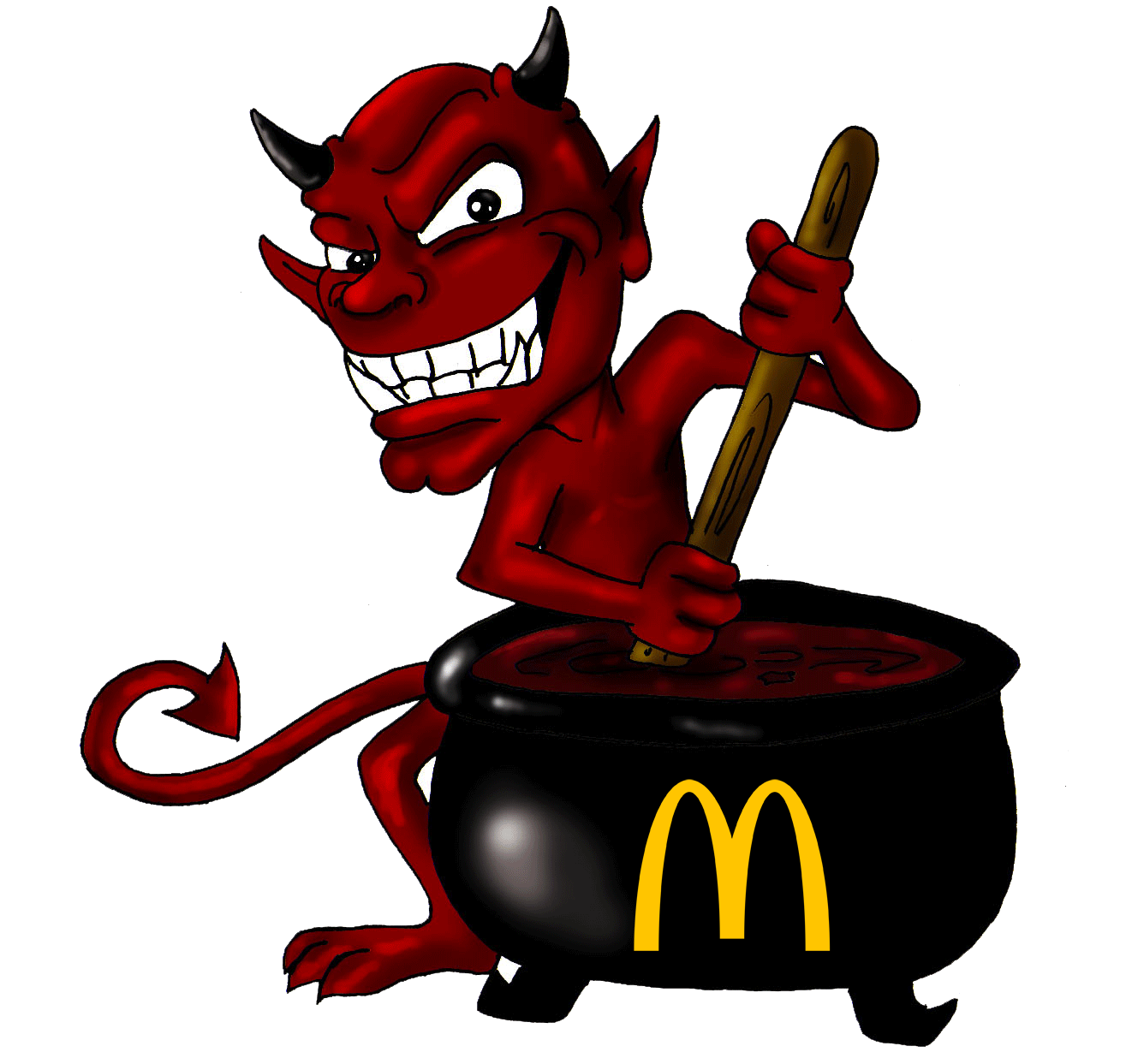 With Thanksgiving behind us, many Americans will not assemble together for a home-cooked meal again for a while.
With Thanksgiving behind us, many Americans will not assemble together for a home-cooked meal again for a while.
By some estimates, people living in large cities consume the majority of their meals outside the home — at restaurants, coffee shops, bars and food trucks. No surprise, then, that anti-obesity policies are increasingly focused on helping Americans make healthier choices when eating in these establishments. Such policies range from gentle informational campaigns (such as the FDA’s calorie count mandate) to heavier-handed policies (such as former New York City Mayor Michael Bloomberg‘s attempt to ban the sale of large sodas).
But with evidence suggesting that calorie information requirements are too hands-off to impact behavior, and with courts concluding that soda bans are too hands-on to be legal, anti-obesity experts are pushing for a more moderate policy intervention. That is why fat and sugar taxes may soon be coming to your local restaurant.
The thinking behind such sin taxes is straightforward: If you make unhealthy food more expensive, people will be less likely to buy it. The problem with this simple way of putting it is it doesn’t capture the complex way people respond to economic signals when dining out. (Please click here to read the rest of the article and leave comments.)
Time To Stop Paying For Pepsi With Food Stamps
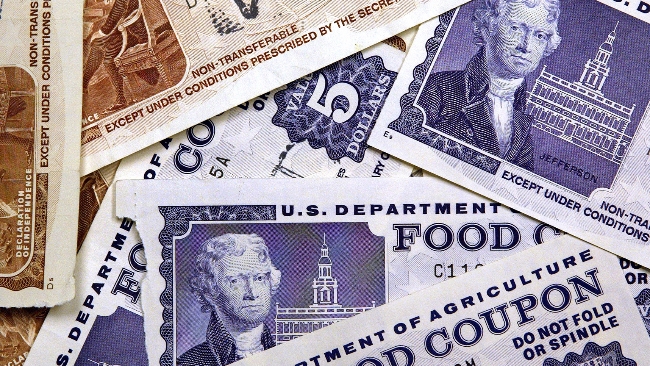 The food stamp program helps over 40 million Americans pay for groceries. Unlike other forms of economic assistance, this program, called SNAP (the Supplemental Nutrition Assistance Program), only pays for food, thereby constraining how recipients make use of the aid. But are food stamps constrained enough?
The food stamp program helps over 40 million Americans pay for groceries. Unlike other forms of economic assistance, this program, called SNAP (the Supplemental Nutrition Assistance Program), only pays for food, thereby constraining how recipients make use of the aid. But are food stamps constrained enough?
SNAP recipients experience higher rates of obesity and diabetes than the general population. Experts estimate that SNAP recipients consume almost twice as many calories from sugar-sweetened beverages, like Pepsi and Coke, than they do from vegetables and fruits. These dismal statistics have caused some experts to use food stamps to nudge people toward healthier behavior.
But how best to nudge? And what might such nudging accomplish? (To read the rest of the post and leave comments, please visit Forbes.)
My Burrito Has How Many Calories?!?
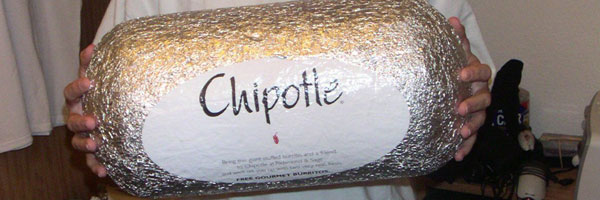 In collaboration with Peggy Liu and Jim Bettman, I’ve had fun doing some research on just how hard it is for people to guess how many calories they are consuming, at restaurants like Chipotle where everyone puts different ingredients on their burrito. Here is the beginning of an absolutely excellent journalist’s take on the topic:
In collaboration with Peggy Liu and Jim Bettman, I’ve had fun doing some research on just how hard it is for people to guess how many calories they are consuming, at restaurants like Chipotle where everyone puts different ingredients on their burrito. Here is the beginning of an absolutely excellent journalist’s take on the topic:
Maricelle Ramirez is a foot soldier in America’s battle against obesity. For three years, Ramirez has politely offered Boston area patrons of McDonald’s, Kentucky Fried Chicken, Burger King, Dunkin’ Donuts, Wendy’s and Subway a $2 gift card in exchange for their estimates of the amount of calories in their fast-food feasts.
“I’ve met all types of people,” Ramirez says, recalling the surprise of encountering a nutritionist who was on her way out of McDonald’s after chowing down on a burger and fries. “She explained that she was just enjoying a meal because she had a craving for something indulgent, but she provided a very careful nutritional analysis of what she was eating”….(click here to read her full article)
A Park Bench That Tells You You’re Fat?
Clearly we in the United States are not taking the obesity epidemic as seriously as the Russian government. We debate whether it is appropriate for the government to require restaurants to inform their customers about how many calories they are consuming. Whereas in Moscow, sit at a park bench, and it will tell you how much you weigh!
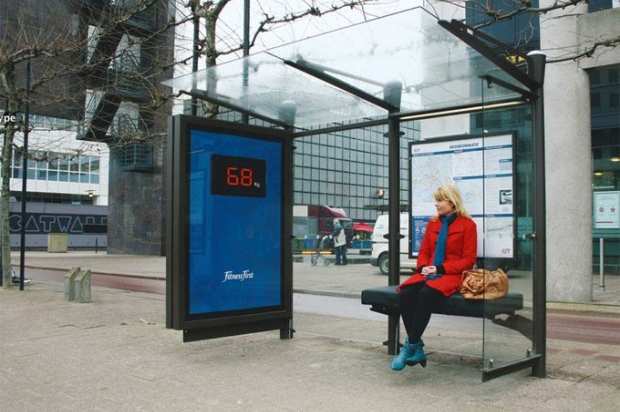
There’s all kinds of problems with this “nudge,” of course, starting with the fact that this woman has an overstuffed purse joining her atop the bench. But you have to give the Russians credit for trying to change the culture of obesity.
Designing a Better Restaurant Menu
My friend and colleague Brian Wansink, from Cornell University, worked with some colleagues to design a preliminary restaurant menu, that maximizes the odds the people will order healthy foods. Trick number one: don’t call them “healthy” foods.
Here is an image of that menu, reproduced in the Atlantic.
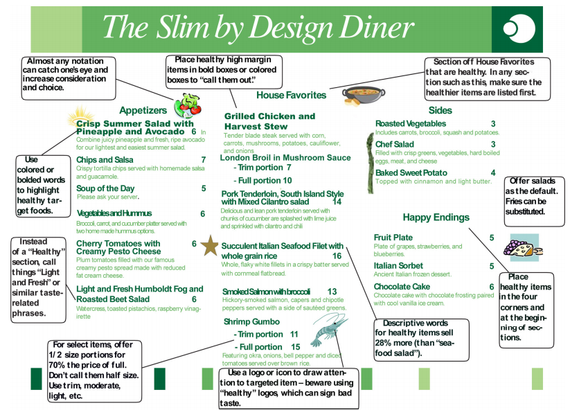
This is a great example of how to use behavioral science to improve the well-being of the general public. Hurrah!
Red Robin, Red Robin, Please Clog My Arteries!
A while back, one of my favorite journalists – Sarah Kliff, from Vox – published a picture showing which chain restaurants win the award for offering the highest calorie entrées. I figured it was time to recirculate this gallery of infamy. Here is the Vox picture of these award winners:
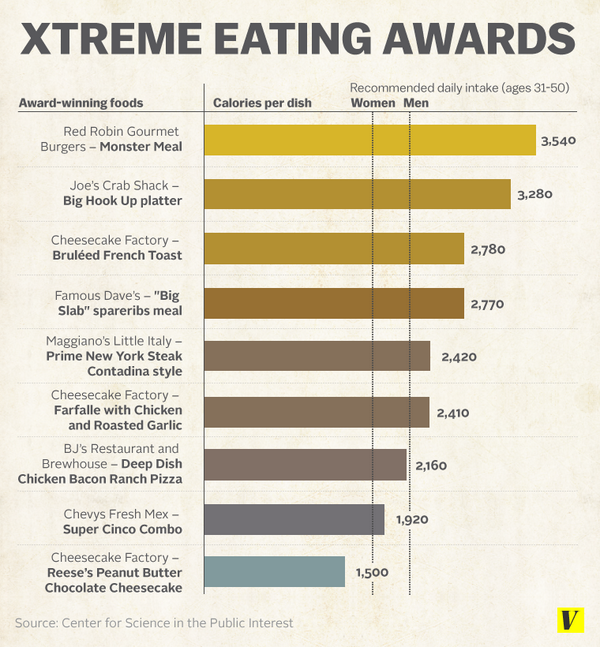
These are truly staggering sums. Most of these meals, on their own, exceed the appropriate daily calorie intake for an adult. That Red Robin Monster Meal – packs enough calories to tide healthy adults over for the better portion of the work week. I hope the people who created these entrées are ashamed of their “accomplishments.”
